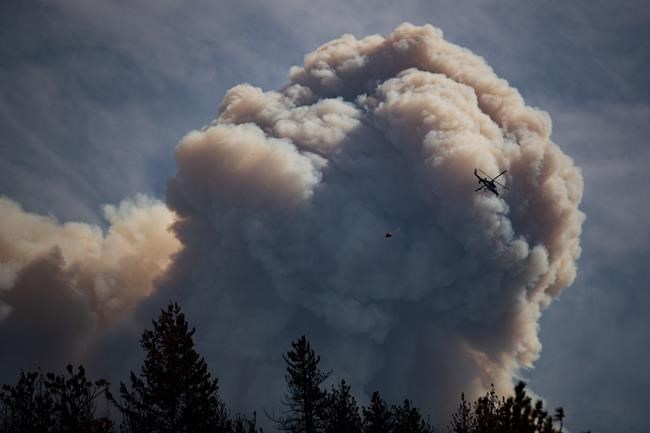Two wildfires fanned by gusty winds roared through British Columbia's southern Interior leaving behind a trail of destroyed properties, says a spokeswoman for the area's regional district.
Laura Wilson, with the Regional District of Central Okanagan, said Monday up to 60 properties may have been "significantly damaged" by the White Rock Lake wildfire.
There has also been "limited structural damage" reported because of the Mt. Law wildfire also burning in the district, she said.
"At this time, we still can't confirm that number," Wilson said. "We're just working with BC Wildfire in order to get into the area to kind of confirm those properties."
Evacuation orders also cover about 500 properties in the Glenrosa neighbourhood of West Kelowna because of the Mt. Law wildfire, while evacuation alerts are posted for many more homes in the area.
Public Safety Minister Mike Farnworth said the Mt. Law fire is being investigated as human-caused.
"The wildfire danger throughout much of the Interior continues to be extremely serious," he said.
"And we are in for a challenging fight in the coming days, given the conditions we're seeing in our communities and on our highways."
Rick Manwaring, the provincial deputy forests minister, said officials are "not in a position to describe the total number of structures" damaged by wildfires in B.C. this season.
He said the local governments are keeping track of the information, which he said is sensitive and changes daily.
"We haven't been tracking it on a provincial basis at this point."
The White Rock Lake wildfire is now estimated to be almost 650 square kilometres while the Mt. Law blaze is about eight square kilometres after being sparked late Sunday north of Peachland.
Wilson said the White Rock Lake fire damaged rural properties, vacation houses and people's homes along Okanagan Lake.
"We continue to have hot and dry conditions here in the Interior B.C.," Wilson said.
"While we have a couple of days of cooler weather forecast right now, winds continue to be an issue for our crews, making fire behave very radically and actively."
The entire cities of Armstrong and Merritt are on evacuation alert, along with the community of Barriere, north of Kamloops, affecting about 14,000 residents in total. Residents of roughly 700 properties on the southwest side of Kamloops have also been told to be ready to leave as four separate wildfires are out of control in those regions.
DriveBC, the online traveller information system, said the Coquihalla Highway between Hope and Merritt remains closed until further notice after flames cut the route late Sunday.
Forests Minister Katrine Conroy said nearly 7,700 square kilometres have burned since the start of the fire season.
Strong winds late Sunday fanned many of the nearly 270 fires currently burning in B.C., including more than 30 considered highly visible or a threat to life and property.
Conroy described the conditions as "some of the toughest" the province has experienced, made worse by unprecedented heat and severe drought in many areas.
"This is not a normal fire season by any measure," she said.
A news release from Emergency Management BC said there are nearly 75 evacuation orders and about 120 evacuation alerts in the province affecting thousands of people.
Environment Canada called for showers over some of the areas where the most aggressive wildfires are located on Monday, including Kamloops, Kelowna and Vernon, but forecasters say any rain could also include lightning, increasing the potential for further fires.
Ian Meier, executive director of the BC Wildfire Service, said the medium-to-short-term forecast shows cooling and a more seasonal outlook for the rest of August.
The outlook for September is similar to what was seen in August, Meier said, adding the forecast shows a possible "better reprieve in October."
"Not a lot of moisture at all, though, for the rest of August and into September."
This report by The Canadian Press was first published Aug. 16, 2021.
Hina Alam, The Canadian Press



